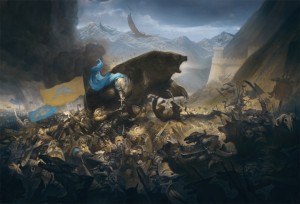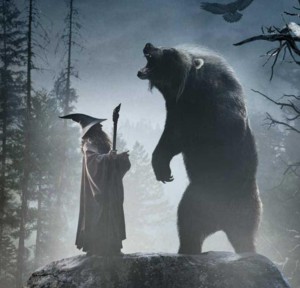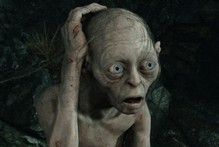Fimbul
Description:
“The exceedingly cruel orc Fimbul is one of Azog’s master hunters. He commands a horde of warg riders who trace their victims in the saddle of their gigantic wolf beasts. Fimbul has taken up the scent of Thorin Oakenshield & Co. and will catch the dwarves before they reach the Lonely Mountain.”
Analysis and speculation:
It would appear that the filmmakers are beefing up the role of the wargs in the trilogy. The wargs begin to chase the dwarves on their escape from the Misty Mountains. In the book, they do not appear again once the Company is rescued by the eagles. However, it is suggested that the Company must hurry to Mirkwood lest they be found by the goblins.
My supposition is that the dwarves are chased up trees by a pack of wargs led by the orc Yazneg. However, once Azog realises one of the dwarves is Thorin, he will set his ‘master hunter’, Fimbul, on their trail. Fimbul is therefore likely to be a feature of the second half of film one and most of film two, harrying the Company all the way to the base of the Lonely Mountain.
This could include following their barrels from the banks all the way to Laketown, forcing the Dwarves to remain in the barrels on the water for the whole distance (why else would they stay in cramped barrels? Without this, simply floating down the river in barrels is not particularly cinematic. It may work in the book, but on film it would be a little anti-climatic; this would also create a form of danger once they disembark at the end of the Long Lake and make their way through Dale, if they are trying to avoid being tracked by Warg-riders.
I wouldn’t be surprised if there is a come-uppance for this character late in the second film. Perhaps they succeed in stealing the ponies from the Company on the slopes of the Lonely Mountain, only to be unfortunate enough to be therefore on open ground when Smaug torches the mountain side and eats the ponies, thereby unwittingly aiding the dwarves by getting ride of what had become a constant source of anxiety — Fimbul and his warg riders.
Bolg & Beorn
 Description:
Description:
“Bolg is the offspring of Azog the Desecrator — like his father, he is huge pale orc. He is the overseer in the dungeons of Dol Guldur — torturing is his hobby. He garnishes his armor with the bones and the blood of his victims. This husky Orc fears nothing and nobody — until he suddenly meets an unexpected opponent.”
“The gigantic Beorn is the last of the ancient people of the skin changer: He can transform into a huge bear-like creature. He lives alone, only tolerates the company of his beloved animals and does not appreciate any visitors — especially not dwarfs. Gandalf knows that the companions have to take the risk and ask Beorn for help, because otherwise they will hardly survive their journey through Wilderland.”
Analysis and speculation:
As noted above, it would appear that Azog has been moved to be the leader of the Goblin forces at the Battle of the Five Armies, the key conflict of the third film. This makes sense, as Dain can still be the one who kills him, but it happens in this battle rather than at the Battle of Azanulbizar, which will likely only be referenced in flashback while the Company are being told by Elrond about the history of the swords they found in the trolls’ cave.
This works because the filmmakers appear to have taken his son, Bolg, and made him the overseer of the dungeons of Dol Guldur, Sauron’s stronghold in the south of Mirkwood. This will achieve a solid connection between the goblin hordes in the mountains, the history of dwarf-goblin antagonism, and the goblins and the ‘rising evil’, i.e. Sauron.
We can safely assume that the Battle of Dol Guldur will occur in the second film. This is because it would simply not fit in the first film, as Gandalf only leaves the Dwarves when they enter Mirkwood, which will be at least two hours into An Unexpected Journey. It would also not fit in the third film, as Gandalf will have to quickly be at the Lonely Mountain in the first hour of that film, as he is involved in the build-up to the Battle of the Five Armies.
The Battle of Dol Guldur will thus likely be intercut, throughout the first half of the second film, with the Company’s escape from the Wood-elves, recuperation in Laketown, exploration of the Lonely Mountain and Bilbo’s interactions with Smaug. This intercutting will be necessary, as that sequence for the Company is rather low-key and dialogue heavy. By the time the Battle of Dol Guldur is wrapping up, Smaug has been antagonised and is ready to scour the mountain and then attack Laketown.
No doubt Bolg will be the chief Orc under Sauron in Dol Guldur, and given that Sauron himself escapes the assault, Bolg will be the main antagonist in that battle.
Yet here an interesting point arises. Remember that, in the book, Bolg is ‘torn down and crushed’ by Beorn, who kills the orc while rescuing Thorin. Now if Azog has replaced Bolg at the key antagonist of the Battle of the Five Armies, and is killed by Dain, then it makes sense for Beorn to be the one who kills Bolg in Dol Guldur.
This would make sense. Remember Beorn, like Gandalf, stops shadowing the Dwarves at the eaves of Mirkwood. Tolkien doesn’t say where he then goes. But while the Dwarves are staying with Beorn, Bilbo hears the sound of many bears outside while they are sleeping. In short, Beorn himself has an army of sorts.
 In the film, it is possible that Beorn and Gandalf join forces, and travel south to Dol Guldur, joining with Radagast en-route, who is representing Saruman. Together, these three assault Dol Guldur. Beorn would bring some ‘muscle’ to the assault, both personally and through his forces.
In the film, it is possible that Beorn and Gandalf join forces, and travel south to Dol Guldur, joining with Radagast en-route, who is representing Saruman. Together, these three assault Dol Guldur. Beorn would bring some ‘muscle’ to the assault, both personally and through his forces.
But also we should examine the symbolism surrounding Dol Guldur. Bear in mind that the Necromancer has, from Dol Guldur, cast a shadow over a previously green forest, hence its name Mirkwood. Indeed, in The Hobbit, Mirkwood is described as without birdsong.
In The Two Towers, it was the trees themselves that fought back against the ravages and perversions of Saruman and Isengard. It would therefore seem to make sense that the Battle of Dol Guldur is the animal kingdom that is fighting back against the evil that has driven all animal life from Mirkwood. This makes all the more sense when we see that the assault might well include Radagast (a wizard defined above as more interested in animals than people), who could rally animals to the cause, and Beorn, who is himself a bear and has animals and bears at his command. In short, Dol Guldur will likely not be a battle of armies, but rather a battle of living nature against the unnatural dead (the name ‘Necromancer’ of course suggests an ability to animate the dead).
Beorn then may or may not himself come to the Battle of the Five Armies, although that role always seemed strange in the book. Everything about the character is of a homebody, and the Lonely Mountain is a long way from his home territory. How would he get there so fast? Why would he bother? It is quite possible the character does not appear at the Battle of the Five Armies if he plays a critical role in the Battle of Dol Guldur. To play a critical role at both would be tantamount to deus ex machina.
With regard to Bolg, having him killed at Dol Guldur by Beorn would create a clear incentive for Azog to seek revenge and attack the Lonely Mountain. Thus in changing the arrangement of scenes (Bolg appears at Dol Guldur, not the Battle of the Five Armies; Azog dies at the Battle of the Five Armies, not the Battle of Azanulbizar), but keeping the scenes themselves intact (Beorn killing Bolg; Dain killing Azog), the films might manage to expand on Tolkien’s very basic notes without having to make scenes up wholesale.
Gollum
 Description:
Description:
“Gollum was once a Hobbit-like creature named Smeagol whose body and soul have been poisoned by a small, plain gold ring, which he hid in a gloomy cave in the Misty Mountains. Gollum does not know what is going on with “his treasure” — but he realizes that it is more valuable than his life. After the chance encounter with a strange enemy Gollum realizes that he has lost “his treasure”, and rightly concludes: The hobbit Bilbo Baggins of the Shire has stolen it. So begins the hunt over mountains and through deserts that takes years and costs many lives, until in the end this miserable creature holds the fate of Middle-earth in his hand.”
Analysis and speculation:
This description suggests that the films will follow Gollum once he leaves the Misty Mountains. The mention of ‘deserts’ is interesting, as this is one landscape we have not seen in the LotR trilogy.
It is plausible that Gollum could only leave the mountains through the ‘backdoor’ of Goblin town after all the Goblins have left to take part in the Battle of the Five Armies. Thus he will likely not appear in film two, unless as a cameo at the end if the goblins have discovered by then that the dragon is dead, and Azog discovered that Bolg, his son, is also dead (a discovery that likely sends him into a rage and causes him to summon all goblins from across the mountains to attack the Lonely Mountain).
Gollum will therefore likely have a few scenes throughout the third movie, tracking his progress across Middle-earth, and eventual capture and torture once he reaches Mordor (probably at about the time of the Battle of the Five Armies).
My own highly speculative hunch is that the films will end by showing Gollum entering Moria. Perhaps, in a clever dovetail, it could show Gollum witnessing the shooting of Balin by an orc archer in the Dimrill Dale (possible Grinnah, as noted above), an event in the book that leads to the orc re-invasion of Moria, as discovered by the Fellowship in FotR. In FotR, of course, Gollum is given a cameo stalking the fellowship in Moria. No explanation is given in that film of how he got there.


